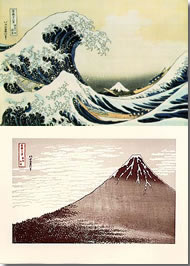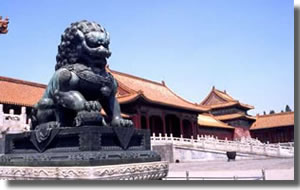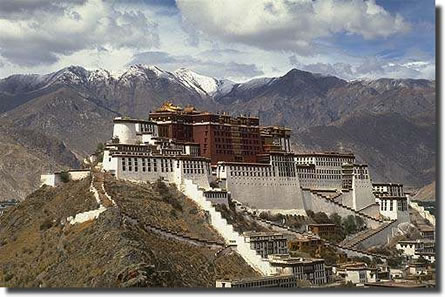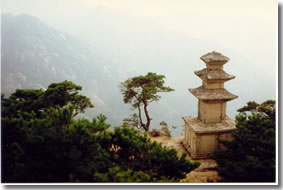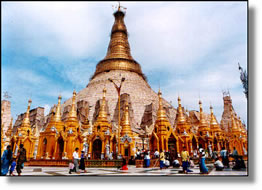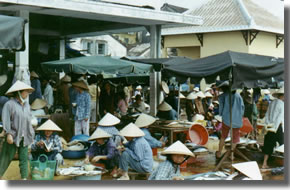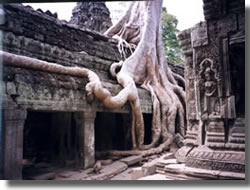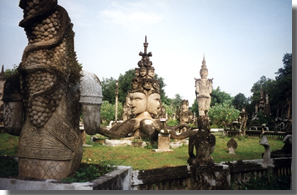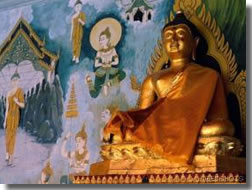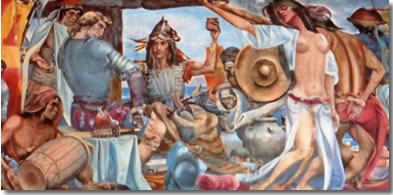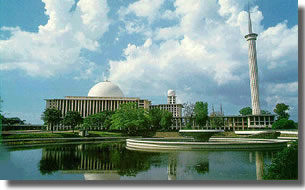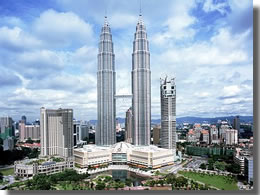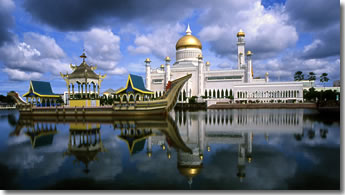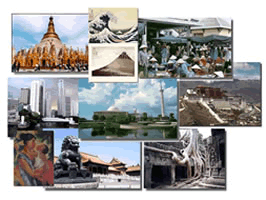 | Introduction Trying
to describe "Asia" as a cohesive body would be all but impossible -
I prefer to look at Asia as a "Cultured Space." The diversity and complexity
in each country and further broken down to sub-sections within each country lends
itself to making sweeping generalizations about East Asia, the Asia Pacific, or
Southeast Asia all but impossbile. This Asian Studies page is an attempt to give
that geographical region (or "space") the much deserved complexity.
The page is demarcated by country sections. In the country section directly following
the "Asia" section, some countries will have a formal academic engagements
sub-section others will not. The sub-section following the formal engagements
(i.e. papers, etc.) is a more informal sub-section that involves a set of reviews
on books and/or movies that fed into my more formal submissions (soon to have
links to the items on Amazon.com). By demarcating the two, any visitor to the
page can either go directly to the review section or peruse the papers (or PowerPoint
presentations) first and then move on to the reviews get an idea on some of the
specific text used as reference -- the visitor is, in effect, given a choice.
For detailed information on any items listed
on this page, please feel free to explore and do be generous with your feedback. |
Reflections
on Asia | | |  | The
Emergence Of Modern Southeast Asia: A
New History: This is the most comprehensive introductory text on Southeast Asian
History that I have come across in many years. Despite there being several survey
books such as Mary Somers Heidhues' Southeast Asia - A Concise History an in-depth
examination of the political and/or economic history of the Southeast Asia is
much appreciated as a pedagogical tool. Owen's compilation is different from most
because of its comprehensive and balanced approach. It is my opinion that the
collection does well in capturing the essence of the region's multiple dimensions.
From colonialism to globalization this book guides you through the complexity
of the region that we begin to get by reading Heidhues' `A Concise History.' Along
the same lines, editors and writers comprehend how hard it is to amalgamate the
scholarly energies of eight authors of different generational situations and yet
come up with a consistent and accessible book - a book on the histories of ten
nation-states that have complex and interrelated narratives. The writers, in particular
- Owen, should be applauded for accomplishiing this Herculean task in less than
four years after commencement. The book itself is the metaphor of the "unity
in diversity" that is Southeast Asia. The writers are self reflective of
the ever-changing dynamics not just of Southeast Asia but the ever-changing perspective
of the region as well and this volume is "a fresh look at modern Southeast
Asian History", deliberately as a "shorter more accessible text for
the twenty-first century" (p. iv). The book is arranged into 37 chapters
in five parts. The editor's aim is to map out the "processes of historical
transformation" as well as to reveal the "chronological narratives of
events" unfolding across time and space (p. xi). Despite its omissions and
errata it is still arguably one of the most comprehensive works of its kind. |
|
|
Southeast Asia: A Concise History: Despite
there really only being about 10 or 11 countries in Southeast Asia, the diversity
of the "space" under consideration seems to almost on purpose wish to
confuse the student. The people of this region although similar on many levels
are very different in just about every category making it very difficult to try
a unifying description. There are very few comprehensive overviews of the region
and this is one very good attempt at a synthesis. Other books like Gerald Tan's
ASEAN Economic Development and Cooperation and Norman Owen's The Emergence of
Modern Southeast Asia are too specific and too detailed respectively. But the
need is there for comprehensive books of this kind. Mary Somers Heidhues is unapologetically
a specialist in early modern Indonesian history. However, despite this limitation,
she has penned a book that is consistent and temporally complete - on a thematic
level. She writes in a language that is both accessible and understandable. Understandably
she will miss some details - details that is the job of other writers in other
venues to do. The book starts with Southeast Asia's earliest migrations and settlements
and terminates in the modern nation states that we have today. Each section is
thematically organized arguably unconsciously playing out the fact that the whole
region is really more integrated than first meets the eye. Notions of water movement
and rice are the first things that come to presence. The notion of China and India
as the two pillars is almost canon. Rice farming certainly played a significant
role in the cohesion and development of techniques that are shared in the region.
Culturally, the introduction of Islam with Hindu-Buddhist as well as animist/indigenous
cultures (not to ignore Christianity) is explored in the book. The exploration
of Japanese wartime occupation is crucial in understanding contemporary Southeast
Asia and leads very well into the current nation-states. Despite the lack of attention
to pet notions of most scholars of the region Heidhues has delivers a book that
will be useful to teachers like myself who are looking for an easy survey of the
regions rich historical complexity - it is a good start. The book also wonderful
resources that help students begin to understand the region: maps, a lexicon,
as well as a list of references and an index. Despite quickly being dated I will
continue to use the book for as long as I teach this topic. |  | Golden
Arches East: McDonalds in East Asia: Golden Arches East: McDonalds in East
Asia is an absorbing read that delves into more than just eating; it grapples
with the big issues like the impact of local vis-à-vis the global by looking
into the interplay of McDonald's in five Asian economies. Watson, et al come to
the conclusion that in several spaces - particularly in Asia - McDonald's has
been amalgamated into the local communities. McDonalds has integrated so well
that the distinction between local and foreign has blurred. So disentangled is
the distinction that McDonalds is no longer considered a foreign restaurant and
arguably in many cases - such as the ones explored in this book - no longer functions
as one. This is an essential book because it accurately portrays and cognizant
of local nuance how a transnational culture is developing. Golden Arches East:
McDonalds in East Asia is a must be read for anyone interested in globalization
studies. It is accessible and to the point that is can, should be, and will be
used for courses in Asian studies, Political Science, and Sociology.
At a time
when academics frequently write impenetrably this book is a breath of fresh air.
Golden Arches is very engaging and is deals with one straightforward question:
how do countries act in response to McDonald's, and conversely what does the relation
say about those countries? The inquiry is not petty. The book is an exploration
of McDonald's in Hong Kong, Beijing, Taipei, Seoul and Tokyo. Undoubtedly, McDonald's
has had a huge effect in Asia, impacting manners and values and also the way people
interact. The most informative part of these studies is its exploration of how
McDonald's changed each country. While Americans might see themselves as the bright
light of global democracy and human rights its impact in countries in East Asia
is proving to be more empirical.
Bathrooms in Hong Kong restaurants, according
to this study had undergone a tremendous transformation. Riding into town with
the McDonalds penchant for cleanliness, the other restaurants seem to have followed
suit. It might seem like an exaggeration but Watson et al credits McDonald's for
assisting in elevating the cleanliness and safety standard in public rest rooms
in Hong Kong. Another thing that is happening in Hong Kong is the "disciplining"
of the users. According to Watson et al the carceral community takes care of its
own. Self reflective of exaggerating McDonalds impact in the milieu, Watson et
al claim that even if McDonalds did not indeed take the active role in creating
a form of queuing discipline - it s perceived to have done so.
Moving onto
the perhaps the marquis section of the book, Japan's values have been changing
for decades, becoming steadily more casual, and according to Watson et al McDonald's
may be assisting as vehicle in that process. This proves at least one thing -
that there is nothing primordial or essential about cultures but that culture
and societies change, reinvent themselves, and reify their existence by the re-enforcement
and performance or cultural play. To the chagrin of conservatives, this is reality.
According to Emiko Ohnuki-Tierney, Japan has a long standing taboo against "tachigui,"
(standing while eating) but that seems to be steadily breaking down. Ohnuki-Tierney
suggests that perhaps the catalyst of this change is McDonald's - whose stores
in Japan just did not accommodate sitting - there were no chairs. In Beijing,
restaurants where known for their noise and dirt. But according to Watson et al,
customers at McDonald's branches in Beijing spoke in hushed tones and were cognizant
of the changing conditions regarding spitting and rubbish.
All this might look
like American cultural imperialism - as is examined in the section on Seoul. However
it is difficult to conceive of even the most zealous anti-American in East Asia
disapproving of American exports like efficiency, smiles and clean rest rooms.
The real potency of Golden Arches East: McDonalds in East Asia is that the writers
place in context not just the food side of McDonald's, but more importantly the
and social and cultural impact of McDonalds on these ever changing societies.
These are loaded tales of the mundane and everyday. In short, this is a rare academic
engagement that should reside in all libraries and spawn similar studies.
|  | The
Arts of Southeast Asia: "Burma became the centre from which Theravada
Buddhist orthodoxy was disseminated to the rest of the region, and it had a part
to play in the spread of artistic concepts and styles, including those derived
from Sri Lankan tradition" writes Fiona Kerlogue on page 114 of her fascinating
book The Arts of Southeast Asia. With close 200 pictures, over half that number
in color, the book is first of all a cornucopia to the visual senses. Not playing
a secondary role is the book's function as an academic resource. Fiona Kerlogue's
The Arts of Southeast Asia also has a glossary and a list of references that suggest
other sources or further reading. Even for the unitiated, The Arts of Southeast
Asia is a wide-ranging preamble to the panoply that is the arts and culture of
the cultures space of Southeast Asia. The book should have a broad appeal to audience
as diverse as students and travelers to the most hardened academic. Kerlogue deftly
explores and explains in 5 distinct but interrelated sections, the pagodas of
Burma, the temples of Angkor, as well as the great Buddhist monument of Borobudur.
To be able to do that she self-reflectively divides her exploration into seven
sections which include a Hindu, Buddhist, Islamic, and Chinese section. Aware
that it would not be informative to divide the region into the current configuration
of artificial borders, Kerlogue brings us back before she brings us forward. Few
books resonate to people (or should) as to leave a lasting impact and the reader
better educated for the experience - Kerlogue provides that experience here. She
moreover explores the influence of the political (as formerly mentioned, the religious
as well) of Art into culture and vice versa. Art is a powerful medium that functioned
as vehicle for tradition - which needed a trained eye to include fabric, architecture,
and rural community crafts. The range and the research relating to the broad subject
must have been amazing. Kerlogue covers up to but is not limited to the inland
countries of Vietnam, Laos, Cambodia, Thailand, and Burma, as well as the maritime
countries of Malaysia, Indonesia, and the Philippine. Kerlogue takes us back to
the core of the expansion of the arts of this unique (although not "uniquely
unique") region from prehistory to the present day. For her efforts, Kerlogue
should be acknowledged with 5 stars and read by more than the academic community
where I found this gem. |  | East
Asian Civilizations: A Dialogue in Five Stages: East Asian Civilizations:
A Dialogue in Five Stages is a short but very informative book. The book is aimed
at the layperson rather than the specialist. De Bary, the wise lecturer that he
is guides the reader along novel comparison between Eastern and Western ways of
thinking. The book is divided into six mini-lectures.
In the first section
"The Classical Legacy" de Bary guides us through the classical inspirations
surrounding Confucianism. Referring back to the Book of Documents and the Book
of Odes we begin to see the foundations of Confucianism and Neo-Confucianism.
De Bary follows quickly with "The Buddhist Age" showing the dynamic
tension provided by the introduction of Buddhism into China vis-à-vis the
more homegrown Confucianism, Legalism, and Taoism. Providing an alternative to
diminishing Han power at the center, Buddhism becomes a force to contend with.
De Bary begins his third section "The Neo-Confucian Stage" with reference
to Reischauer and his study of Ennin - one of the last great individuals (de Bary
43). The section is a reflection on the impact of Yen Hui as a human ideal and
the humanist quality of the age. De Bary pegs the development of Neo-Confucianism
on Chu-His (1130-1200) (de Bary 48). De Bary notes:
"I have said earlier
that the Confucians were primarily scholars, teachers, and leaders in their home
community, not proselytizing missionaries. Thus ironically, it took accidents
of history and the dislocation of war and conquest to spread the Confucian word
abroad. Mongol conquerors captured the Confucian scholar Chao Fu in 1235, took
him to Peking, and set him up in an academy in the capital, and from there Neo-Confucian
teachings spread in the north. Later Korean princes, held hostage by the Mongols
in Peking, studied Neo-Confucianism there and eventually brought it back to Korea,
where it soon became a potent force, culturally and politically. It was Japanese
Zen monks, successors to Ennin as pilgrims to China, who first brought the new
philosophy to Kamakura-period Japan. Korean scholars, taken as prisoners of war
in the Hideyoshi invasion of their homeland, and the displaced Ming scholar Chu
Chi-yu, a refugee from the Manchu conquest, completed the process of its transfer
to Japan" (de Bary 59-60).
In "East Asia's Modern Transformation"
de Bary notes of East Asia as a space of flux. De Bary situates the transformation
period to 1840 for the Chinese (the Opium War) and 1853 in Japan with Perry's
arrival. No matter what, it is clear that this socially constructed epistemology
certainly had a region-wide impact. According to de Bary, Confucianism continues
to do so. In "The Post-Confucian Era" - which de Bary contends is the
first half of this century, we see the rise of Mao's red China. Arguably, Communism,
a cultural force that is also defined by developed bureaucracy could not have
been as successful in China if it had not been for the preparatory configuration
of a strong center developed by Confucianism. Likewise, the converse is true for
Japan with its developed feudal system - it seemed less likely to something as
developed at the center as Communism to take a foothold. In the sixth and final
section "East Asia and the West: Catching Up with Each Other" we see
a very different de Bary - one who almost seems like an apologist for "Asian
Values." A humanist movement, Confucianism is here to stay and continues
to have profound impact on East Asia (China, Japan, Korea, and Taiwan) as well
as Vietnam and Singapore in Southeast Asia.
Aside from the specifics outlined
above, de Bary has also written a short but valuable roadmap the culture of East
Asia were Confucianism still lives. The short piece is the personal notes of a
great scholar who is an expert of the big picture - deftly making generalizations
were some can be made but also navigating the particulars were apt. A must read
on all levels. |  | The
Vision of the Buddha: Tom Lowenstein's "The Vision of the Buddha"
is arguably one of the most accessible books on the subject. Moreover, he not
only brings Buddhism and its development to presence for the novice user - he
brings in a whole set of other issues making it a very comprehensive book. I highly
recommend it. This is a handsomely illustrated and, as previously mentioned, extensive
book on Buddhism. Lowenstein bring Buddhism to life with over 200 illustrations.
Included in the 200 illustrations are pieces relating to art, archeological artifacts
and examples of architecture. Lowenstein also includes pictures of rituals and
practices that go a long way to explain as it accompanies his superb text. "The
Vision of the Buddha" explores important concepts, sensitively explores living
values and ways of life as well as the religious and psycho-social angles of the
dogma and, inevitably its connection to modern-day Western society.
As a pedagogical
tool, this book is second to none. The Buddha's instruction and the prominent
tenets of Buddhist philosophy are described in depth. More importantly, this book
follows the spread of Buddhism from its Indian roots to Sri Lanka, Southeast Asia,
China, Japan, and Tibet. Each area or country has a chapter set aside for it -
which makes it really easy to understand. Moreover, it allows the author to explore
in some detail the uniqueness of Buddhism and its development in discrete spaces.
The really neat thing about this book - aside from its length - is that frequently
difficult doctrine is clearly drawn out in clear and simple language - without
sacrificing its authority and seriousness. Harkening back to the book as a pedagogical
tool, the book includes a reference section at the back that includes a guide
to the most important Buddhist sites, a section on present-day Buddhist masters,
a comprehensive glossary, as well as a list of Buddhist groups for further exploration.
In
short, this book is an excellent introduction to the subject for a novice; as
well as providing an in-depth overview of Buddhism for the knowledgeable reader
who would like to increase the breadth and depth of their understanding of this
very old and venerated path. |  | A
Modern Buddhist Bible : Essential Readings from East and West: Arguably
"A Modern Buddhist Bible" Donald Lopez is the most accessible piece
relating to the development of modern Buddhism. This "Bible" is a compendium
of 20th-century works that have formed modern Western understanding of Buddhism.
Lopez, who also penned "Prisoners of Shangri-La: Tibetan Buddhism and the
West" (another book I highly recommend and is also available on Amazon.com)
put together a canon for understanding contemporary Buddhism. Despite taking a
straightforward chronological approach, Lopez is keen to interconnect all the
influential figures that form what he sees as a lineage. The interpretive introduction
brings together the sundry of authors together into a he sees as a development
of modern Buddhism taking us back 2500 years to the Buddha's unique vision. Productive
and inexhaustible Tibetan Buddhist scholar Lopez deftly advances his thesis for
framing a modern appreciation of Buddhism that is based on history and brings
original texts as well as considers practice. This absorbing book does not present
canonical texts, such as the Lotus Sutra, of ancient Buddhism to modern readers.
Instead, Lopez defines "modern Buddhism" through the writings of 31
authors who came to presence between 1873 and 1980. This panoply of authors includes
such notables as Theosophists Madame Helena Blavatsky and Henry Steel Olcott to
more contemporary and identifiable thinkers such Thich Nhat Hanh, and the Dalai
Lama. Lopez illuminates using biographical sketches and then the entry with original
text. Also included are Paul Carus, Alan Watts and the infamous and problematic
W.Y. Evans-Wentz. W.Y. Evans-Wentz is the individual responsible form making The
Tibetan Book of the Dead "accessible" in the West. The selections are
themselves diverse. The earlier 20th century writers provide fascinating views
of the beginnings of the modern Asian-Western encounter of belief systems in the
context of evolving postcolonial political awareness. The Nobel Price award speech
by the Dalai Lama is worth the price of the book. |
| |
World on Fire: How Exporting
Free Market Democracy Breeds Ethnic Hatred and Global Instability by Amy Chua:
In World on Fire: How Exporting Free Market Democracy Breeds Ethnic Hatred
and Global Instability, Amy Chua takes the bold step by re-inventing bringing
ethnicity to the center of the argument. Chua's point of commencement is that
in several developing nations a small "market dominant" ethnic minority
holds economic dominance in a nation. Oftentimes, the same economic disparity
is glaring. Based on this visible disparity, such "market dominant"
ethnic minorities, Chua argues, attract resentment. Where the visibility is really
glaring and the conditions are right, the resentment can result in very violent
outcomes. At times, to borrow from Chua, the disparity has grows more acute with
western-inspired globalization. Chua posits, and I wholeheartedly agree, that
UNREFLECTIVE foisting of free market capitalism and liberal democracy by the west
can cause UNINTENDED CONSEQUENCES (293). What begins to come to presence is that
in the vast portion of the developing world, economic power is concentrated in
what Chua calls "market dominant" ethnic minorities often with ties
to the government - a government at can at any time conjure up the demons of ethno
nationalist resentment. Chua suggests that in an effort to quell this resentment
a set of relief valve mechanism can and perhaps should be considered. One of the
more compelling arguments Chua makes is that this chasm that has formed between
the elite outsider group and the local indigenous group forms a deep fissure that
only results in political instability. As a digression, Chua's range is so broad
that reading this book one's mind is boggled at the breadth and depth of coverage.
Back to the issue of political instability, as an example of this breadth and
depth, she examines cases from reaction to Chinese in Southeast Asia to the mass
killing of Tutsis by the Hutus in Rwanda and the resentment felt and subsequent
disaster resulting from the same by Serbs towards Croats in the Balkans.
In
the west, the hypothesis is that: democracy leads to a more open-minded and non-judgmental
society, but in cases where the social order is distinct by an intense ethnic
divide, the opposite may be more reflective of reality on the ground. Chua writes:
"Societies with a market-dominant minority face a specially formidable problem:
class conflict and ethnic conflict overlap in a particularly explosive way. The
rich are not just rich, but members of a hated outsider ethnic group. In societies
with no market-dominant minority, the division between the few who are rich and
the many who are poorer is unlikely to be ethnicized - but it remains, at least
potentially, a source of conflict. Wherever democracy and capitalism are joined
together, mass political movements directed against the rich become a possibility,
fueled by resentments and demagogic manipulation similar to (but usually less
murderous than) that which arises in the presence o market-dominant minorities"
(190-191). Which lends itself to the possibility that the issue is not ethnic/racial
but class and if the change is too sudden then the resentment that has been waiting
to express itself is suddenly given vent and results in "unintended consequences"
(293) oftentimes, as is evidenced by Chua's vast array of case studies - often
violently.
Towards the end of the book, Chua shifts from an almost limited
country based examination to a more regional and global discussion when she takes
her thesis of "market dominant" ethnic groups to the cases of Israel
and the United States. If Israel is seen as a regional "market dominant"
ethnic minority in the middle-east and the United States is seen as "market
dominant" ethnic minority country in the world - than all the forces meted
out to those who situate themselves in that space consequently meet predictably
with the same resentments meted out to the countries already examined. Is it naïve
of Chua to think that the same sorts of relief valve mechanism that she suggest
to countries in Southeast Asia and Africa - and which have been proven to work
in such places as Canada - to Israel and the United States? Is it naive to ask
for a relief of the resentment meted out against Israel and United States by such
productions as "spreading the wealth" and holding a "greater stake"
which might work on a more limited country level? Would not Israel and the US
be subject to a sort of `double-bind' where security in the Middle East and the
world are so pegged to the perception of economic and military dominance of the
same? Who knows? Perhaps that is the very thing that Chua is warning us about.
Not to suggest that Chua is trying to find easy solutions to difficult problems
but she is making a clear, sustained, and courageous attempt to break things down
to their component parts and add complexity. Nonetheless, the strength of the
argument relating to the ethnic component and the racialization of the same that
Chua brings, and the way she works it, is compelling and should not be ignored. |
|

| Economic
Dynamism in the Asia-Pacific (The Open University Pacific Studies Course) by Grahame
F. Thompson: Economic Dynamics in the
Asia-Pacific edited by Grahame Thompson is a large and diverse collection of articles
by different scholars. It provides a wide range of points of view. One of the
books' high points is engagement in a broad spectrum of topics, not limited to
but including such issues as regionalism, patterns of trade and investment, sources
of economic growth, financial systems, labour markets, the role of the state,
corporate governance, technological innovation and the environment. In this book,
the European Union (EU) is used as a framework for measuring progress of the process
of regional integration in the Asia-Pacific. Diversity in the EU pales if juxtaposed
against the vast social, cultural, political and economic differences in the Asia-Pacific.
Moreover, in comparison to the bureaucratic framework of Europe, regional groups
such as APEC are seen to be a more informal forum, maybe taking into account the
traditional Asian perspective on developing long-term relationships as opposed
to formal contracts. Also, any agreements on special zones is seen to be stimulated
by a market mechanisms rather than national governmental agreements. The analysis
does not stop at the "pro" arguments for integration, but rather also
presented are the arguments against integration. Regionalism, whether inspired
by the EU example or the informality of APEC, is not necessarily in accord with
the multilateral approach to international economic exchange and this is examined
in some detail in the book.
The different corporate frameworks are examined
in this book. Close knit family management and ownership, the performance of many
core activities in-house, and low consultation with subordinates in the Korean
conglomerates, the "chaebol", is juxtaposed against the very different
internal promotion mechanism and reliance on subcontracting as well as consensual
decision-making in the Japanese "keiretsu". Although the canvas is painted
in broad brush strokes and despite the delimited nature of the studies, the book
has explanatory powers. Witness the examination of Taiwan. Taiwan is seen, once
again as different from the Korean model "chaebol" and the Japanese
model "keiretsu". With the state directing the economy, while smaller
companies, civic society, and members of socially linked business groups, controlling
the export trade. Finally, and perhaps the most accessible explanations relating
to the 'flying geese' theory of Akamatsu Kaname comes under fire by Brendan Barker
and Akira Goto. Both Barker and Akira Goto provide a very comprehensive and understandable
examination of a simple yet hard to explain theory.
One important conclusion
that may be useful to other 'late comers' is how complicated the development process
has been in these countries. No simple model provides one pat answer. While in
some countries the state may have played a more pivotal role, in others it may
have been the market and less intervention by the state that set the process in
motion. The Statist model, where the state played a more important role, the nature
of the measures and policies are treated so comprehensively that a non-specialist
can understand it. What is needed, according to this book, are policies that have
been properly tried and tested and efficiently and effectively used but rather
a guide. To put it another way, studies in this collection are not a map for any
development strategy as such but rather as a guide. The most significant thing
to walk away with is the rejection of a "one size fits all" model of
development. It could be argued that according to the IMF and the World Bank have
a lot to learn and can effect change for the better. Another plus to the collection
is the non-dogmatic perspective on development by the scholars who contributed
to this book. The reader is left to make up his/her own mind. In no way can this
book be seen as a one-sided analysis. My understanding of the dynamic region of
Asia-Pacific was greatly enriched by this volume. By reading this book, I have
effected an enhanced and much deeper understanding of the crucial issues and the
possible future of the Asia Pacific. |
| 
| The Political
Economy of East Asia: Post-Crisis Debates by Iyanatul Islam, Anis Chowdhury:
Islam and Chowdhury use the prevailing language of strong versus weak thus fails
to explain a government's ability to cultivate or encumber economic performance.
When discussing East Asia's powerhouse economies--South Korea, Malaysia, Taiwan,
Hong Kong, and Singapore--Islam and Chowdhury have clearly established the inadequacy
of the traditional neoclassical categories. In East Asia, strong, not weak, states
have allowed the private sector to make a sizable contribution to growth. Opposite
to expectation, the "weakest" nation-states in that region--Indonesia
and the Philippines--have not nurtured strong private sectors. As a case in point,
these have been much less successful than the others in generating home demand
and in accumulating capital and skills. Islam and Chowdhury have been very helpful
in making me understand this dynamic.
According to Islam and Chowdhury, the
economic successes of East Asian governments, a new generation of statist scholars
has arisen to champion the role of a strong state in promoting economic development.
Islam and Chowdhury are quick to point out the strong bifurcation in the literature.
On the one hand, a strong state is viewed as an restraint to economic development;
on the other hand, state activism is championed as an essential component in the
most celebrated cases of economic growth since the end of World War II. Who really
knows. Kudos to Islam and Chowdhury for making such a complex subject easier to
understand. According to Islam and Chowdhury, both of these theoretical positions
embody crucial elements of truth, but both, in an of themselves, are too limited
to account for the different economic performances of developing and nations in
East Asia.
In "The Political Economy
of East Asia: Post Crisis Debate" Islam and Chowdhury point out that when
states are too weak to curb their own officials, agents of the nation-state may
act exclusively of one another. Economies in East Asia--Japan, Malaysia, South
Korea, Singapore, and Taiwan--all now the extent and limits on their control over
private-sector profits. As I mentioned above, even if the advocates of state activism
raise sensible doubts about the earlier neoclassical view, it is not clear why
some cases "strong" states promote economic development, while others
carry on policies that encumber it. Islam and Chowdhury are even handed to point
out that countries that have pursued activist policies have also experienced reverse
growth along with increased social inequality. Their treatment of the labor issue
in East Asia is second to none. If just for that alone, I give Islam and Chowdhury
five stars. | |

| The Rise of Asia:
Economy, Society, and Politics in Contemporary Asia by Frank B. Tipton: There
are several positives to "The Rise of Asia" by Frank B. Tipton. First,
the book is deep and it deals with a breadth of subjects. Second, one of the subjects
that it deals with, in some detail, is the economic development of Asia -- which
we all need to understand. Third, over and above the economic development, Tipton
also deals with the role of politics and international relations as factors in
this book. Fourth, Tipton also records the rise of Asia as partially a factor
of Nationalism. Fifth, Tipton records the role of technology as a dynamic in Asian
development. Sixth, he deals with the women's issue. A heretofore-neglected issue,
he has to be commended for bringing the women's issue to our attention. However,
I will later indicate that he needs to bring up the women's issue in light of
a larger field of social implications. Lastly, one of the greatest assets of this
book is the extended bibliography. Despite the "all English" listing,
it is still a valuable list of references. Let us begin by examining the breadth
and depth. Tipton goes from the pre-colonial, through the colonial and then finally
closes with the contemporary. Moreover, Tipton deals with both East and Southeast
Asian countries. Along all these different time frames and countries, Tipton deals
with the territorial governments and precepts of governance relating to these
times and places. What do I mean? In other words, Tipton traces the contemporary
back to pre-colonial and colonial roots of Japan, China, Japan, Korea as well
as Southeast Asia. According to Samuel Huntington, in his book "The Clash
of Civilizations and the Remaking of World Order" (also available on Amazon.com),
East Asian economic development is altering the balance of power between Asia
and the West. Along these same lines, Tipton's "The Rise of Asia" is
a space, of the same kind, to explain the long-term economic growth in East Asia
and beyond.
Tipton is clear that the rise of East Asia as an economic player
in the world scene was not a sudden thing -- it was eons in the making. Tipton
also explores the impact this growth will have on the world scene. The text spotlights
economic development and Tipton puts economic history first. Tipton examines political
and international relations as well. In this book, Tipton explores issues of politics
and international relations. Tipton, in his depth and breadth is surely not quick
to oversimplify anything -- he takes great pains to explain it all the best he
can. Tipton knows that the neo-classical model does not fully explain the whole
of East Asia. For Tipton, East Asia is limited to the Confucian based countries
of Japan and the Four Tigers. In these countries, Confucianism is the basis for
"Value" foundation. Tipton is aware that the difference is the extent
and the form. This reviewer is under the impression the mixed system explanation
is best for the 5 countries involved. Japan is the "poster child" for
government intervention, where the Keiretsu is heavily involved with the government.
Moreover, the Korean elite was heavily involved with the government. Countries
like Singapore, Taiwan and Hong King and were less and less involved with government.
Tipton is aware that it is not simply neo-classical economics but to a large extent
"statist" government intervention as well. It is simply a matter of
figuring how and how much. This book also deals with nationalism and its links
to economic growth. Tipton is good because he looks at Asia in context. Moreover,
Tipton takes seriously the impact that social structures -- such things as civic
society -- have had on the "Asian Miracle." Tipton posits that the economic
success of East Asia is not limited or attributed to Asian Values alone. Tipton
also deals at length with importation of technology as a consequential issue,
especially in East Asia. Tipton uses on whole chapter to examine the issue of
women in Asia. To his credit he does rigorously reflect on the women's issue.
However, Tipton needs to include the women's issue within the larger framework
of all the social ramifications of such rapid growth in such a short time. Then
there is the issue of Tipton's extensive 27-page bibliography. This book certainly
draws from several sources. I was particularly impressed by his reference to Leah
Greenfeld's "Nationalism - Five Roads to Modernity" (also available
on Amazon.com) and her use of Nietzsche's Ressentiment. Despite the range and
depth of the choices for reference, scholars have observed, as did this reviewer,
about the lack of non-English books. Personally, as a non-expert, I would benefit
from seeing more source material reference that is based on languages from the
countries being studied. With a topic such as East and Southeast Asia, one would
think that Tipton would include more local authors. |
 | Seeds
of Terror : An Eyewitness Account of Al-Qaeda's Newest Center of Operations in
Southeast Asia
by Maria Ressa: Just
recently having written about the 9/11 Commission Report, I mentioned that the
report neglected considerations surrounding Southeast Asia. In Seeds of Terror,
Maria Ressa, using her position as CNN bureau chief in Jakarta exploited her access
to obtain interviews with key players, government officials, as well as intelligence
reports and interrogation summaries -- most of them apparently classified and
many until now not printed. Ressa brings all of this related `stuff' narrating
a wide-ranging story of the persons, events, time frame and locations of Jemaah
Islamiyah (JI), who according to Ressa is a transnational Islamic terror network
at the hub -- of which its key allies are Al Qaeda and the MILF in the Philippines.
In this book, Ressa deftly explains JI's Plan B and the eventual bloodshed in
Bali. As a non-academic introduction to the names and places relating to the goings
on in Southeast Asia - this book is an amazing resource. If only for the insider
information and the enormous risk that Ressa took to obtain this valuable information
the book deserves the thumbs up. |
Asia
History Timeline 
Asia
|














